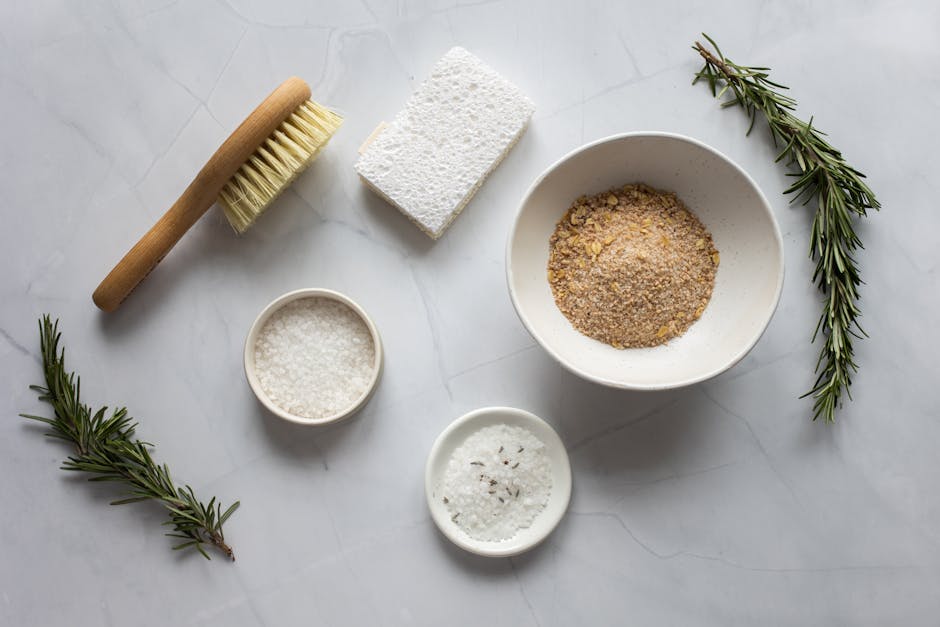Why Natural Exfoliation Methods Are Your Skin’s Best Friend
Natural exfoliation methods offer a gentle, effective way to reveal your healthiest skin without harsh chemicals or environmental damage. These time-tested techniques use ingredients from your kitchen and nature to remove dead skin cells, boost circulation, and improve your natural glow.
Quick Guide to Natural Exfoliation Methods:
- Physical scrubs: Oatmeal, sugar, coffee grounds, or jojoba beads that manually remove dead cells
- Chemical helpers: Yogurt (lactic acid), apple cider vinegar, or buttermilk that dissolve cell bonds
- Enzymatic masks: Papaya, pineapple, or pumpkin that digest dead skin proteins
- Natural tools: Konjac sponges, loofahs, or pumice stones for gentle buffing
Your skin naturally sheds dead cells every 27 to 40 days, but this process slows with age and environmental stress. Dead skin buildup leads to dullness, clogged pores, and poor product absorption. Natural exfoliation speeds up this renewal cycle safely.
The beauty of natural methods lies in their gentleness and sustainability. Unlike harsh scrubs with plastic microbeads or synthetic acids, natural exfoliants work with your skin’s biology. They provide the friction or chemical action needed to reveal fresh cells while often delivering additional benefits like hydration, antioxidants, or anti-inflammatory compounds.
Whether you’re dealing with dullness, rough texture, or simply want to improve your self-care ritual, natural exfoliation can transform your skin without breaking the bank or harming the planet.
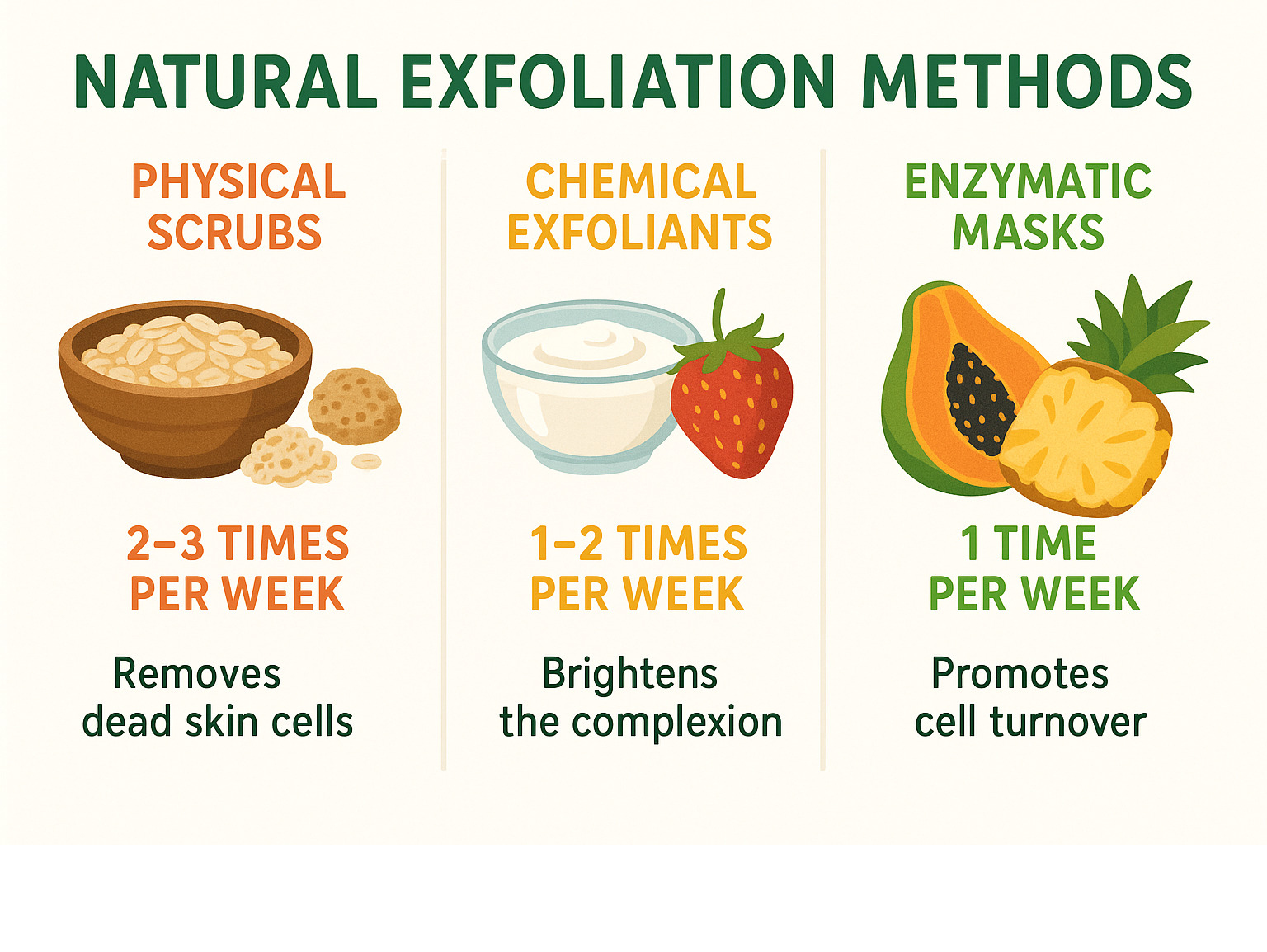
Natural exfoliation methods terms explained:
Exfoliation 101: Why Your Skin Needs It
Picture your skin as a busy city that never sleeps. Every day, millions of skin cells complete their life cycle and need to be cleared away to make room for fresh, healthy ones. When this natural cleanup process gets sluggish, dead cell buildup creates a dull, rough surface that hides your skin’s natural brightness.
This is where natural exfoliation methods become your skin’s best friend. Think of exfoliation as giving your skin the gentle nudge it needs to let go of what’s no longer serving it.
The magic happens when you remove that top layer of tired skin cells. Fresh blood rushes to the surface, boosting circulation and giving you that coveted post-exfoliation glow. Regular exfoliation also dramatically improves product absorption by removing the barrier that prevents your serums and moisturizers from penetrating effectively.
Scientific research on skin turnover reveals another exciting benefit: exfoliation stimulates collagen boost production, meaning firmer, smoother skin over time, plus a reduction in fine lines and aging signs.
The Skin’s Renewal Cycle
Your skin naturally renews itself every 27 to 40 days in healthy adults. New cells are born deep in your epidermis and journey upward, changing from plump, living cells into flat, dead ones ready to be shed.
Here’s the catch: this renewal process slows with age. While young adults enjoy a speedy 28-day turnover, adults over 65 might wait 40 to 60 days. Environmental stressors can slow things down even more.
Key Benefits You’ll Notice
Radiance appears almost immediately – like wiping dust off a mirror. Your skin’s texture becomes noticeably smoother, and even tone develops gradually as dark spots fade. Perhaps most satisfying: fewer breakouts when dead cells can’t stick around to clog pores.
Mastering Natural Exfoliation Methods Step by Step
Ready to dive into the wonderful world of natural exfoliation methods? Think of this as your personal toolkit – each method has its own superpower.
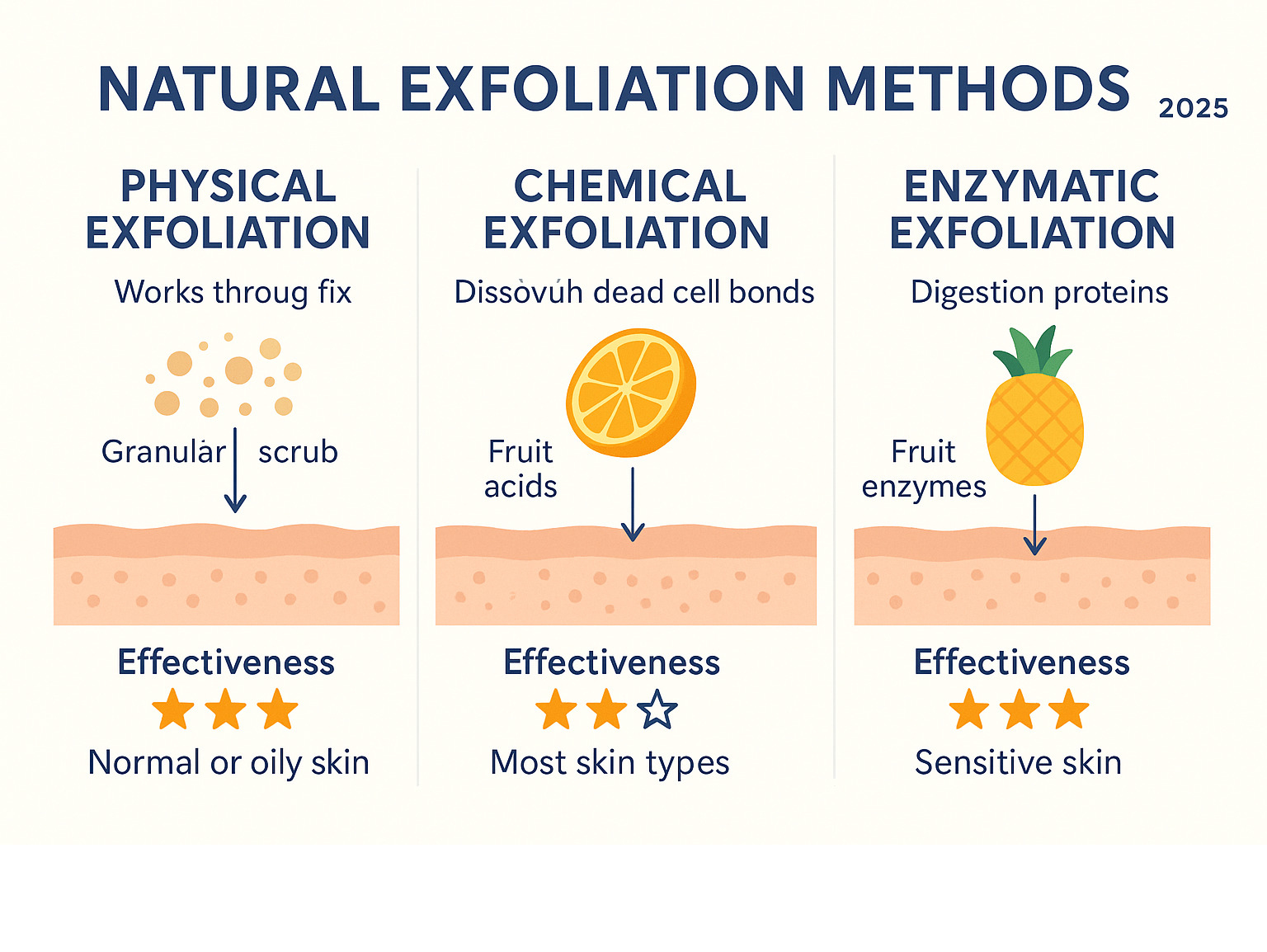
Physical exfoliation uses granular materials that work through friction, manually buffing away dead cells. Chemical exfoliation uses mild acids from everyday ingredients to dissolve the bonds holding dead skin cells together. Enzymatic exfoliation uses fruit enzymes that specifically target dead skin proteins while leaving healthy cells alone.
Physical Scrubs & Tools
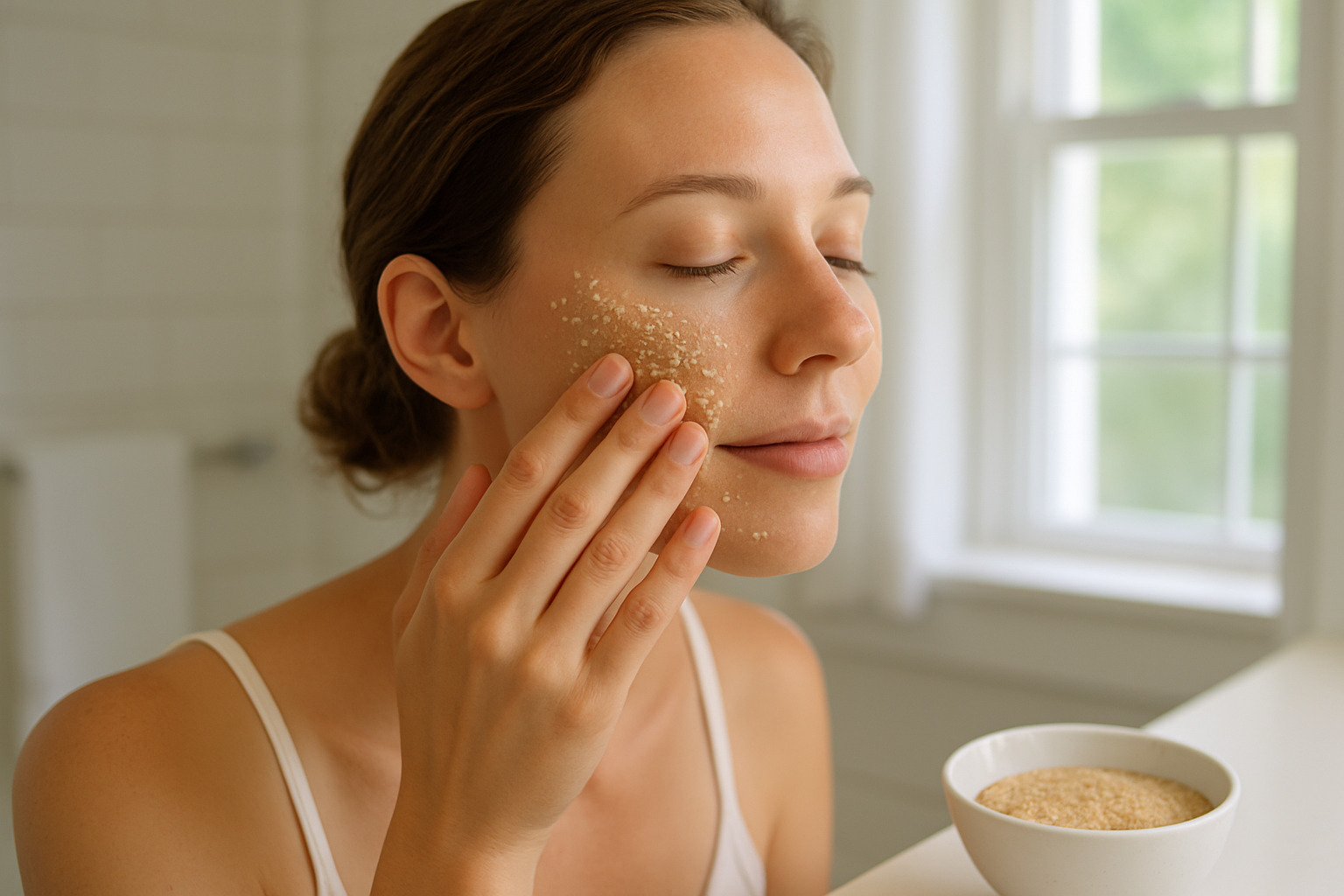
Oatmeal contains beta-glucan, which soothes irritated skin while providing perfect scrubbing power. Grind regular oats into fine powder and mix with water, honey, or yogurt.
Sugar provides physical exfoliation while brown sugar contains natural glycolic acid. Save sugar scrubs for your body since they can be too harsh for facial skin.
Coffee grounds offer gentle exfoliation plus antioxidants from caffeine. Used grounds work beautifully for body scrubs mixed with oils.
Jojoba beads are perfectly round wax beads that glide over skin without creating microtears, making them safe for all skin types.
Natural tools like konjac sponges and loofahs offer reusable options. Use gentle circular motions for 30-60 seconds on facial areas.
Kitchen-Cupboard Chemical Helpers
Yogurt contains about 0.9% lactic acid – much gentler than commercial products. Apply plain yogurt as a mask for 15-20 minutes for softer, brighter skin.
Buttermilk contains 3-4% lactic acid, stronger than yogurt but still gentle. It’s particularly wonderful for dry skin since it exfoliates while adding moisture.
Apple cider vinegar contains acetic acid but demands respect. Always dilute it – mix one part vinegar with three parts water for a gentle toning solution.
Scientific research on alpha hydroxy acids confirms that these natural acids can improve skin texture and reduce fine lines when used consistently.
Enzymatic Fruit Masks
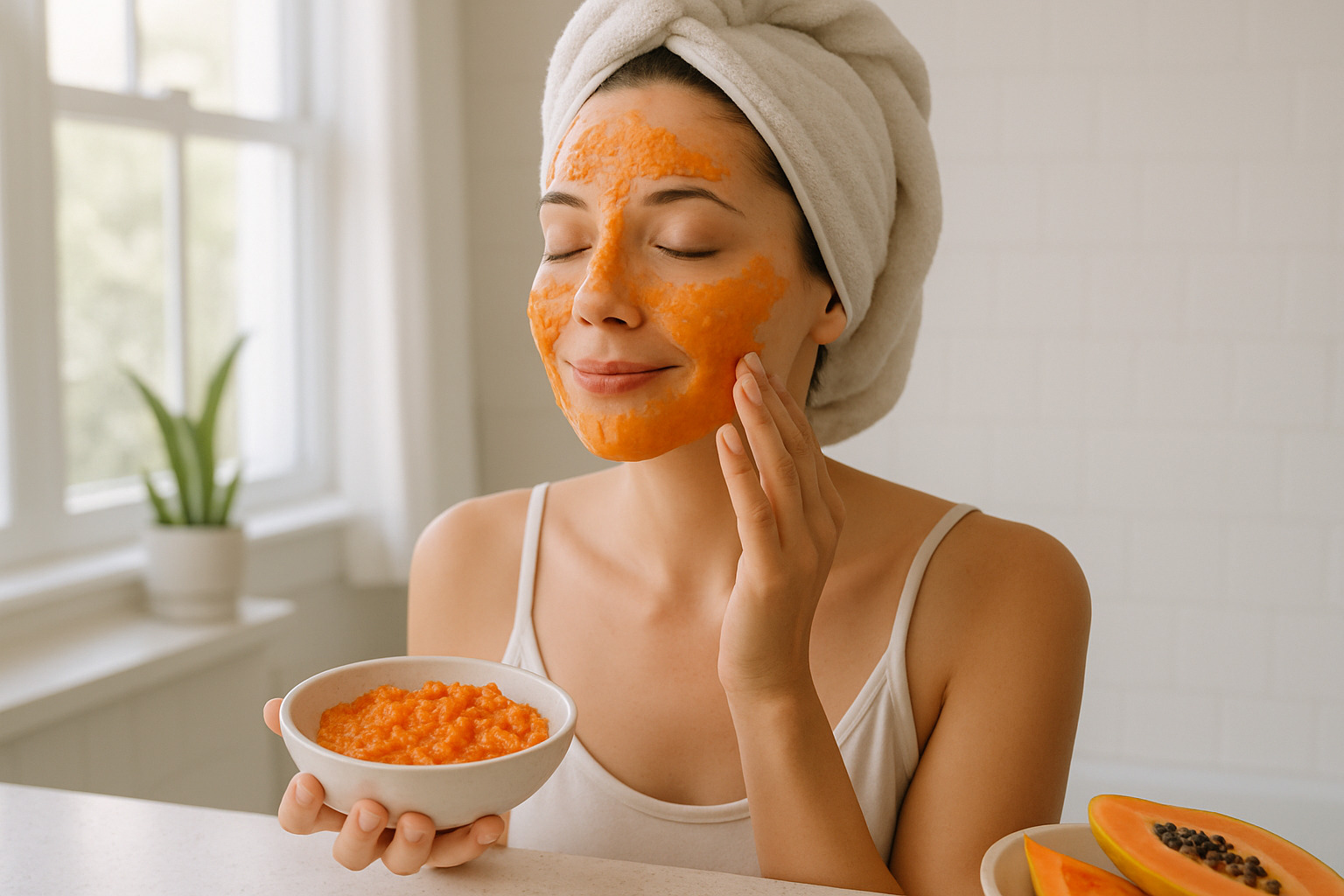
Papaya contains papain, an enzyme that breaks down keratin proteins in dead skin cells. Mash fresh papaya into a paste and apply for 10-15 minutes.
Pineapple brings bromelain, another protein-digesting enzyme. Fresh pineapple can be applied directly or mashed into a mask.
Pumpkin offers natural proteases along with vitamins A and C, working more slowly and perfect for sensitive skin.
Enzymatic exfoliants are temperature-sensitive, so avoid heating them. Most need 10-20 minutes to work their magic.
Choose the Right Exfoliant for Your Skin Type
Finding the perfect natural exfoliation methods for your skin is like finding the right pair of jeans – what works for your friend might not work for you. Your skin type determines which ingredients will work best and how often to use them.
The golden rule: Always patch test first. Apply a small amount to the inside of your elbow, then wait 24-48 hours. This simple step can save you from irritation.
For detailed guidance on choosing ingredients, check out our guide on DIY Skincare Ingredients.
Dry & Mature Skin Needs
Lactic acid from yogurt is perfect for dry skin – it exfoliates while pulling moisture into your skin. Apply plain Greek yogurt as a mask for 15-20 minutes.
Finely ground oats contain beta-glucan that soothes while buffing away dead cells. Mix with water or milk for a gentle daily scrub.
Honey exfoliates through natural enzymes while deeply moisturizing. Raw honey works best – apply directly for 10 minutes before rinsing.
Oily & Acne-Prone Skin Needs
Clay provides gentle physical exfoliation while absorbing oil. Mix French white clay or bentonite clay with water or green tea.
Baking soda mixed with honey controls oil while preventing irritation. Mix 2 tablespoons baking soda with 2 teaspoons honey plus aloe vera gel.
Green tea can be incorporated into any mask for antioxidant and anti-inflammatory properties.
Sensitive or Reactive Skin Needs

Colloidal oatmeal is specifically processed to be extra fine and soothing, often recommended by dermatologists.
Rice flour mixed with water provides very gentle physical exfoliation trusted in Asian skincare for centuries.
Fragrance-free ingredients are essential – avoid essential oils or anything with strong scents.
How Often Should You Use Natural Exfoliation Methods?
Sensitive skin: Once weekly maximum with enzymatic exfoliants
Normal skin: 1-2 times per week, alternating methods
Oily skin: 2-3 times per week, but start with twice weekly
Mature skin: 1-2 times per week with gentle methods
Watch for signs of over-exfoliation: increased redness, sensitivity, or breakouts.
DIY Recipes & At-Home Routine
Creating your own natural exfoliation methods is budget-friendly and lets you know exactly what’s going on your skin. For sensitive skin, check our guide on DIY Exfoliating Scrubs for Sensitive Skin.
Honey-Sugar Body Scrub: Mix 1/2 cup brown sugar, 1/4 cup honey, and 2 tablespoons coconut oil for a luxurious body treatment.
Oatmeal-Yogurt Face Paste: Grind 1/4 cup oats into powder, mix with 2 tablespoons plain yogurt and 1 teaspoon honey for gentle facial exfoliation.
Coffee-Coconut Body Rub: Combine 1/2 cup used coffee grounds, 1/4 cup melted coconut oil, and 1 tablespoon brown sugar for circulation-boosting body treatment.
Storage: Most homemade scrubs should be used immediately or refrigerated for up to one week. Use clean utensils to prevent contamination.
Step-By-Step Tutorial

- Start with cleansing using your regular cleanser
- Dampen skin with lukewarm water
- Apply in gentle circles for 60 seconds on face, 2 minutes on body
- Rinse thoroughly with lukewarm water
- Pat dry gently with a clean towel
- Moisturize immediately while skin is damp
- Apply SPF if it’s morning
Evening routine timing works best since it aligns with your skin’s natural overnight renewal process.
Post-Exfoliation Care
Barrier repair becomes your priority after exfoliation. Use ingredients like ceramides or natural alternatives like aloe vera gel.
Sunscreen is essential – freshly exfoliated skin is more vulnerable to UV damage. Use at least SPF 30.
Avoid active ingredients for 24 hours after exfoliation, including retinoids and additional acids.
Safety, Risks & Patch Testing Essentials
Even natural exfoliation methods deserve respect and caution. Natural doesn’t always mean harmless for every skin type.
Microtears happen when you scrub too hard or use particles that are too rough. Over-exfoliation makes skin look worse instead of better, feeling tight, red, or stinging. Allergic reactions can happen with any ingredient.
The patch testing procedure: Apply a tiny amount to the inside of your elbow or behind your ear and wait 24 hours. Any redness, itching, or swelling means your skin is saying no.
For persistent concerns, consult with a board-certified dermatologist for personalized guidance.
Ingredients to Skip or Use Cautiously
Walnut shells create jagged pieces that can scratch like tiny razor blades. Coarse salt is too harsh for facial skin. Straight lemon juice is too concentrated and can burn your skin while making it sun-sensitive.
Undiluted essential oils can cause severe reactions – always dilute properly. Alcohol-based preparations are problematic after exfoliation when your skin barrier is compromised.
Sunburned skin should never be exfoliated – wait until completely healed.
Frequently Asked Questions about Natural Exfoliation Methods
Can natural exfoliation help with acne, dullness, or aging?
Yes! Natural exfoliation methods are effective for all three concerns. For acne, exfoliation prevents dead skin cells from mixing with oil and bacteria to create clogged pores. Honey brings antibacterial benefits while yogurt provides gentle lactic acid.
For dullness, that lackluster complexion is often just dead skin cells hiding your natural glow. Enzymatic exfoliants like papaya are particularly brilliant here.
For aging concerns, gentle exfoliation jumpstarts your skin’s renewal process and stimulates collagen production. Lactic acid from yogurt is wonderful for mature skin.
Are there special tips for darker or mature skin tones?
Darker skin tones need to be mindful of post-inflammatory hyperpigmentation. Any irritation can trigger dark spots lasting months. Enzymatic exfoliants are often safest, along with rice flour, oatmeal, and honey.
Mature skin has slower cell turnover (40-60 days vs. 28 days for young skin) but is more delicate. The solution is consistent, gentle exfoliation rather than aggressive treatments. Lactic acid from yogurt is perfect.
Both skin types should never skip moisturizer and sun protection after exfoliation.
What’s the quickest DIY option for beginners?
The oatmeal and water paste is perfect for beginners. Grind 1/4 cup oats into powder, mix with water to form a paste, massage gently for 30-60 seconds, then rinse. It’s nearly impossible to mess up and works for virtually all skin types.
Start with once per week and add honey or yogurt once you’re comfortable with the basic recipe.
Conclusion
Your journey into natural exfoliation methods is really a journey back to basics – back to trusting your skin’s natural wisdom and working with it rather than against it. There’s something deeply satisfying about knowing that the ingredients changing your skin come from your own kitchen, not a laboratory filled with unpronounceable chemicals.
The real magic happens when you realize that effective skincare doesn’t have to be complicated or expensive. A simple oatmeal scrub can deliver the same glowing results as products costing ten times more. Your skin doesn’t care about fancy packaging or marketing claims – it responds to gentle, consistent care with ingredients it recognizes and can actually use.
Think of natural exfoliation as a form of self-care that extends beyond your skin. Every time you choose a homemade sugar scrub over a plastic-filled commercial version, you’re making a small but meaningful choice for both your health and the planet. These decisions add up, creating ripples of positive change that extend far beyond your bathroom counter.
Consistency beats intensity every single time. Your skin will thank you more for gentle weekly care than for sporadic aggressive treatments followed by weeks of neglect. Start where you are, with what you have, and build from there. Even busy schedules can accommodate a simple oatmeal paste once a week.
The beauty of natural exfoliation lies in its adaptability. Sensitive skin getting irritated? Switch to rice flour. Dealing with stubborn dullness? Try a papaya enzyme mask. Oily skin acting up? Reach for that honey and baking soda combination. Your skincare routine can evolve with your skin’s changing needs throughout the seasons and years.
Achieving healthy, radiant skin is more like tending a garden than fixing a machine. It requires patience, observation, and gentle nurturing. Some weeks your skin will respond beautifully, others it might need extra gentleness. Both are perfectly normal parts of the process.
For those ready to dive deeper into natural skincare, our comprehensive guide on Natural Skincare Solutions offers a complete roadmap for creating a routine that works in harmony with your skin’s natural processes.
At Beyond Beauty Lab, we believe that education empowers better choices. Understanding why natural exfoliation works – and how to do it safely – gives you the confidence to take control of your skincare journey. You’re not just following trends; you’re making informed decisions based on science and your skin’s individual needs.
Your path to naturally glowing skin starts with a single gentle scrub and grows from there. We’re here to guide you every step of the way, celebrating your successes and helping you steer any challenges. Because at the end of the day, the most beautiful skin is healthy skin – and healthy skin comes from consistent, gentle care that honors your body’s natural wisdom.

